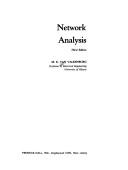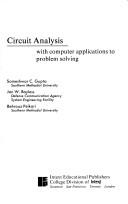| Listing 1 - 10 of 73 | << page >> |
Sort by
|
Book
ISBN: 0738111481 Year: 1998 Publisher: Piscataway, NJ : IEEE,
Abstract | Keywords | Export | Availability | Bookmark
 Loading...
Loading...Choose an application
- Reference Manager
- EndNote
- RefWorks (Direct export to RefWorks)

ISBN: 0136110959 9780136110958 Year: 1974 Publisher: Englewood Cliffs: Prentice Hall,
Abstract | Keywords | Export | Availability | Bookmark
 Loading...
Loading...Choose an application
- Reference Manager
- EndNote
- RefWorks (Direct export to RefWorks)
Book
ISBN: 0060429097 Year: 1980 Publisher: New York (N.Y.): Harper and Row
Abstract | Keywords | Export | Availability | Bookmark
 Loading...
Loading...Choose an application
- Reference Manager
- EndNote
- RefWorks (Direct export to RefWorks)
Book
ISBN: 113917181X Year: 1987 Publisher: Cambridge : Cambridge University Press,
Abstract | Keywords | Export | Availability | Bookmark
 Loading...
Loading...Choose an application
- Reference Manager
- EndNote
- RefWorks (Direct export to RefWorks)
It is the aim of this book to take undergraduates in science and engineering to an acceptable level of competence in network analysis. The author assumes no previous knowledge of the subject. The book starts from basic physical ideas and progresses through essential network laws and theorems to Fourier and Laplace transform methods of analysing transient and steady-state problems. Traditional transient and alternating-current theory is covered prior to introducing transform methods, since the author believes that the gain in physical insight from such an approach is invaluable. Throughout, the relevance of the analysis to practical electric and electronic circuits is stressed. This book will be of value to students in universities and polytechnics in physics and electrical and electronics engineering departments.

ISBN: 0471888508 Year: 1977 Publisher: New York (N.Y.) : Wiley,
Abstract | Keywords | Export | Availability | Bookmark
 Loading...
Loading...Choose an application
- Reference Manager
- EndNote
- RefWorks (Direct export to RefWorks)

ISBN: 070022405X Year: 1972 Publisher: Scranton, : Intext Educational Publishers,
Abstract | Keywords | Export | Availability | Bookmark
 Loading...
Loading...Choose an application
- Reference Manager
- EndNote
- RefWorks (Direct export to RefWorks)
Book
ISBN: 066900443X Year: 1981 Publisher: Lexington Lexington books
Abstract | Keywords | Export | Availability | Bookmark
 Loading...
Loading...Choose an application
- Reference Manager
- EndNote
- RefWorks (Direct export to RefWorks)
Book
ISBN: 0675090741 Year: 1973 Publisher: Columbus Merrill
Abstract | Keywords | Export | Availability | Bookmark
 Loading...
Loading...Choose an application
- Reference Manager
- EndNote
- RefWorks (Direct export to RefWorks)
Book
Year: 1997 Publisher: [Washington, D.C.] : US Army Corps of Engineers,
Abstract | Keywords | Export | Availability | Bookmark
 Loading...
Loading...Choose an application
- Reference Manager
- EndNote
- RefWorks (Direct export to RefWorks)
Book
ISBN: 0309293987 0309293960 Year: 2013 Publisher: Washington, DC : The National Academies Press,
Abstract | Keywords | Export | Availability | Bookmark
 Loading...
Loading...Choose an application
- Reference Manager
- EndNote
- RefWorks (Direct export to RefWorks)
"The Resilience of the Electric Power Delivery System in Response to Terrorism and Natural Disasters is the summary of a workshop convened in February 2013 as a follow-up to the release of the National Research Council report Terrorism and the Electric Power Delivery System. That report had been written in 2007 for the Department of Homeland Security, but publication was delayed because of security concerns. While most of the committee's findings were still relevant, many developments affecting vulnerability had occurred in the interval. The 2013 workshop was a discussion of the committee's results, what had changed in recent years, and how lessons learned about the grid's resilience to terrorism could be applied to other threats to the grid resulting from natural disasters. The purpose was not to translate the entire report into the present, but to focus on key issues relevant to making the grid sufficiently robust that it could handle inevitable failures without disastrous impact. The workshop focused on five key areas: physical vulnerabilities of the grid; cybersecurity; mitigation and response to outages; community resilience and the provision of critical services; and future technologies and policies that could enhance the resilience of the electric power delivery system. The electric power transmission and distribution system (the grid) is an extraordinarily complex network of wires, transformers, and associated equipment and control software designed to transmit electricity from where it is generated, usually in centralized power plants, to commercial, residential, and industrial users. Because the U.S. infrastructure has become increasingly dependent on electricity, vulnerabilities in the grid have the potential to cascade well beyond whether the lights turn on, impacting among other basic services such as the fueling infrastructure, the economic system, and emergency services. The Resilience of the Electric Power Delivery System in Response to Terrorism and Natural Disasters discusses physical vulnerabilities and the cybersecurity of the grid, ways in which communities respond to widespread outages and how to minimize these impacts, the grid of tomorrow, and how resilience can be encouraged and built into the grid in the future."--Publisher's description.
| Listing 1 - 10 of 73 | << page >> |
Sort by
|

 Search
Search Feedback
Feedback About UniCat
About UniCat  Help
Help News
News